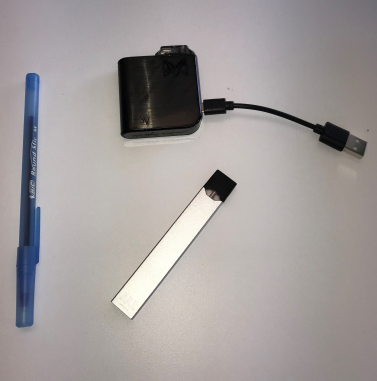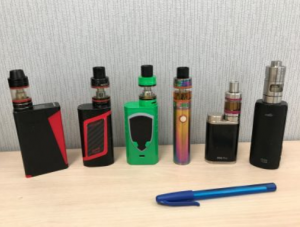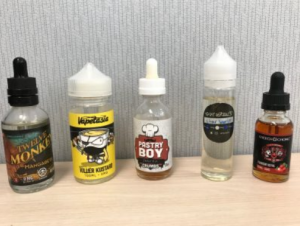Vaping
Vaping fact sheet for parents and educators
Consider the Consequences of Vaping: Information from Health Canada
Health Risks of Vaping
Talking with your teen about vaping: a tip sheet for parents
Thought About Quitting? (2022 Youth Cessation Resource)
Facts About Vaping
What is vaping? Is there a difference between an e-cigarette, a mod, or a vape? Is vaping healthy? What is in e-juice? Can my child get addicted to vapes? Does vaping lead to smoking? What laws affect e-cigarettes? This page will answer many of the questions that parents have about these devices.
Vapes come in many shapes, colours, and sizes and are often mistaken by parents as USB drives.



What’s in a name?
Whatever you call it or whatever it looks like each device operates under the same premise and is designed to deliver vapour into the users’ lungs.
The Smoke-Free Ontario Act that regulates e-cigarette use says an electronic cigarette is “a vaporizer or inhalant-type device, whether called an electronic cigarette or any other name, that contains a power source and heating element designed to heat a substance and produce a vapour intended to be inhaled by the user of the device directly through the mouth, whether or not the vapour contains nicotine.”
Is vaping healthy?
The Ontario Tobacco Research Unit (OTRU), sponsored by the University of Toronto, the University of Waterloo and the Centre for addiction and Mental Health is a main source of scientific, non-industry funded research about e-cigarettes.
This video produced by OTRU, “To Vape or Not to Vape”, quickly explains some of the research:
The National Academies of Sciences, Engineering, and Medicine has also produced one of the most comprehensive studies to date called The Public Health Consequences of E-Cigarettes. Highlights from that report (available here) indicate:
- “There is conclusive evidence that in addition to nicotine, most e-cigarette products contain and emit numerous potentially toxic substances.
- There is substantial evidence that except for nicotine, under typical conditions of use, exposure to potentially toxic substances from e-cigarettes is significantly lower compared with combustible tobacco cigarettes.
- There is conclusive evidence that e-cigarette devices can explode and cause burns and projectile injuries. Such risk is significantly increased when batteries are of poor quality, stored improperly, or modified by users.
- There is conclusive evidence that completely substituting e-cigarettes for combustible tobacco cigarettes reduces users’ exposure to numerous toxicants and carcinogens present in combustible tobacco cigarettes.”
In short:
- Non-smokers should not vape
- Vaping is likely far less harmful that smoking
- Some smokers may quit using e-cigarettes
- E-cigarettes are NOT a silver bullet
What is in e-juice?
Generally, e-juice (the liquid substance put in an e-cigarette or vape) contains these main ingredients: vegetable glycerin, propylene glycol, flavours, and nicotine.
One thing that the Centre for Disease Control notes is that “it is difficult for consumers to know what e-cigarette products contain. For example, some e-cigarettes marketed as containing zero percent nicotine have been found to contain nicotine.”
There are more than 7,000 flavours of e-juice available to lure young Canadians and kids. These range from cotton candy to chocolate or mango. Young people are drawn to flavours more than any other group. In fact, more than 83 per cent of young e-cigarette users (15-19 years of age) report using fruit and candy/dessert flavoured vapes. Dressing up a nicotine-based product with candy and dessert flavoured names hides the product’s harm and increases its appeal. There is more to flavoured e-juices than hides behind the vapour. #GetTheScoop
Visit lung.ca/vaping for more information about the harms of vaping.” (Ontario Lung Association)

Can my child become addicted to e-cigarettes?
- “There is substantial evidence that e-cigarette use results in symptoms of dependence on e-cigarettes.”
Does vaping lead to smoking?
There are many major studies that conclude that youth that use e-cigarettes are more likely to use conventional cigarettes:
- The National Academies of Sciences, Engineering, and Medicines report concludes that “There is substantial evidence that e-cigarette use increases risk of ever using combustible tobacco cigarettes among youth and young adults.”
- The Propel Centre for Population Health at the University of Waterloo found that students who vape are at twice the risk for smoking conventional cigarettes
- “Since e-cigarettes came on the market there has been a debate about whether their use may lead to cigarette smoking,” said Bruce Baskerville, co-author on the study and a researcher at the Propel Centre for Population Health Impact at the University of Waterloo. “The answer among adolescents is yes.”
- The Centre for Disease Control states that “Young people who use e-cigarettes may be more likely to smoke cigarettes in the future.”
What laws affect e-cigarettes?
Provincially: The Smoke-Free Ontario Act regulates the use of cigarettes, e-cigarettes, and medicinal cannabis use. You have to be 19 years of age to purchase an e-cigarette in Ontario.
Locally: Bylaw 18-114 prohibits the use of e-cigarettes in most public spaces including at parks, playgrounds, beaches, splash pads, and sports fields. Fines can be levied by Tobacco Enforcement Officers, police officers, and bylaw officers. The Townships of Selwyn, Douro-Dummer, and Cavan Monaghan also have bylaws that protect residents and visitors from second-hand smoke and vapour.
If you or someone you know is interested in quitting smoking and/or vaping, please call Peterborough Public Health to learn more about your options, and what supports are available. (705) 743-1000
Factsheets:
Multi-unit residences 2018
Retailers 2018
Sporting area 2018
Waterpipe 2018

